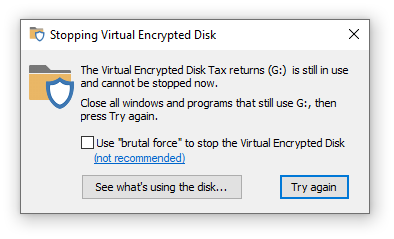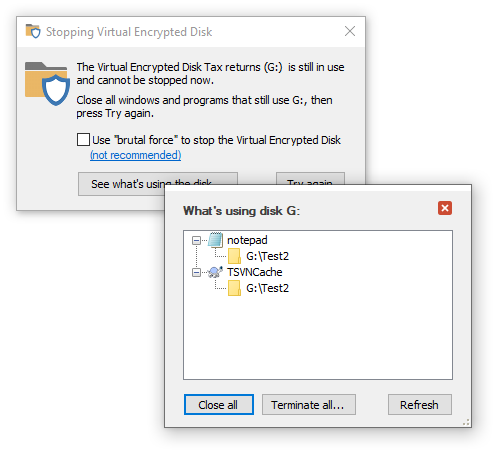Stopping the Virtual Encrypted Disk |
When you are done working with the encrypted files located inside of a Virtual Encrypted Disk, you need to stop the Virtual Encrypted Disk, that is, return it into the state in which its contents is inaccessible to anyone who does not know your password.
Encryptability offers several methods of stopping Virtual Encrypted Disks. If you have the Encryptability application open on the screen, you could select the Virtual Encrypted Disk(s) in its list and choose Stop command from the Encryption menu. However, you don't need to run the Encryptability application specifically to do that: a faster is by using the system tray icon menu:
![]()
When you choose the Stop command from the menu, Encryptability attempts to stop the Virtual Encrypted Disk. If there are no files in use on the Virtual Encrypted Disk, it usually takes just a second or two to stop it. However, if some files are still in use, you may see the following message instead:

If you see this message, the first thing to try is to do what it suggests: close any program that might still be using files off the Virtual Encrypted Disk, including any Explorer windows that might be displaying the contents of the Virtual Encrypted Disk, then press Try again.
If you are not sure which programs are still using the Virtual Encrypted Disk, press the Show what's using the disk button and it should open a popup showing the processes that still have files open on the encrypted disk, such as this:

You can use this information to close the listed applications, as you normally do, usually by closing their windows. If for some reason the application does not close normally, you can right-click on each process and choose to close or terminate it. Or, press the Close all button to make Encryptability to try to close all listed processes. If some of them refuse to close, you can choose to Terminate them instead. However, use these tools only as the last resort, as they can result in a system instability. The preferred way is to close each application normally.
After closing the listed processes, press the Try again button to try to stop the Virtual Encrypted Disk again. If the same message keeps appearing, it might be that some system process or a hidden window is still using a file on the Virtual Encrypted Disk. If you are sure there are no windows or programs that you can close to remedy the situation, there are two courses of action you can take:
The safest method is to restart your computer. (Note that putting the computer to sleep and then waking it up may not work, a complete restart may be required). When the computer restarts, any Virtual Encrypted Disk that stops unconditionally, and when the computer starts again, the Virtual Encrypted Disk remain stopped, until you start it by entering the correct password.
If you are in a hurry and don't want to wait for the computer to restart, you can try the brutal force option shown on the screen above. However, this option should be used only if you are sure there are no open files with unsaved changes. If some file happens to have unsaved changes to it, the unsaved changes may be lost when you stop the Virtual Encrypted Disk "brutally".
In any case, after you stop the Virtual Encrypted Disk (normally or "brutally") its contents becomes locked. All files and folders that the Virtual Encrypted Disk contains at that point become encrypted and completely inaccessible to anyone. The only way to get to the files stored inside of the virtual Encrypted Disk is to start it again, by entering the correct password.
That describes the typical cycle of the use of an encrypted USB drive: when you need to use the encrypted files, you start the Virtual Encrypted Disk. When you are done working with the files, you stop the Virtual Encrypted Disk.